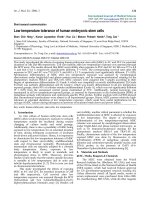human evolution
Bạn đang xem bản rút gọn của tài liệu. Xem và tải ngay bản đầy đủ của tài liệu tại đây (331.4 KB, 12 trang )
Evolution
Contents
1.
2.
3.
4.
5.
6.
7.
8.
Human Evolution
Lucy
Discovery of a Lifetime
Outdoors Type
Tough to Chew
Out of Africa
Neanderthal Man
Mini Test
Human Evolution
Ardipithecus ramidus
The most primitive.
4.4 million years ago.
first fossils found 1992
Australopithecus anamensis
Exhibiting some chimp-like characteristics.
4.2 - 3.9 million years ago
first fossil found 1965
Australopithecus afarensis
This species includes "Lucy," the 3.2 million year old fossil.
3.5 - 2.9 million years ago
first fossils found 1973
Australopithecus africanus
3.0 - 2.4 million years ago
first fossils found 1924
Australopithecus robustus
2.1 - 1.6 million years ago
first fossil found 1938
Australopithecus boisei
2.3 - 1.1 million years ago
first fossil found 1959
Homo habilis
2.4 - 1.5 million years ago
first fossil found 1960
Homo erectus
1.8 million years ago 300,000 years ago
first fossil found in 1893
Homo sapiens (archaic)
500,000 - 200,000 years ago
first fossil found in 1921
Homo sapiens neanderthalensis
230,000 - 30,000 years ago
first fossil found in 1856
Homo sapiens (modern)
120,000 years ago - present
first "Cro-Magnon" specimens found in 1868
Lucy
•
One fossil discovery above all has transformed views of how we became human. But who was Lucy, and why
is she so important to human evolution?
•
Lucy was discovered in 1974 by anthropologist Professor Donald Johanson and his student Tom Gray in a maze of
ravines at Hadar in northern Ethiopia.
•
Johanson and Gray were out searching the scorched terrain for animal bones in the sand, ash and silt when they
spotted a tiny fragment of arm bone.
•
Johanson and Gray named their fossil skeleton Lucy, after the Beatles song 'Lucy in the Sky with Diamonds'. Lucy
may have looked something like this.
Discovery of a lifetime
Lucy
• An upright chimp
• Admired from Afar
• Standing tall
• Forest origin
• Chimp cousins
Outdoors Type
Homo erectus travelled long distances on foot, as it worked hard to scavenge enough meat to feed its
growing body and brain.
Tough to Chew
•
Homo habilis had small teeth and ate anything it could lay its
hands on, especially meat. But habilis was no hunter.
•
In East Africa, a hominid called Paranthropus boisei became
specialised so that it could eat tough-to-chew but more abunda
nt plant foods such as nuts, roots and tubers (largely undergrou
nd vegetables, the potato being a modern example).
Out of Africa
Shortly after Homo erectus appeared 1.8 million years ago, humans began to leave Africa for the
first time and migrate to other continents.
Early humans reached Dmanisi in ex-Soviet Georgia around 1.8 million years ago.
"They may have used bamboo to make spears for hunting and poles to knock animals down from
the tall trees"
Neanderthal Man
•
Neanderthal man, or Homo neanderthalensis, had a jutting nose set in a large face with
massive brow ridges and no chin. From around 190,000 years ago, they lived across Europe
and the southwest of Asia.









